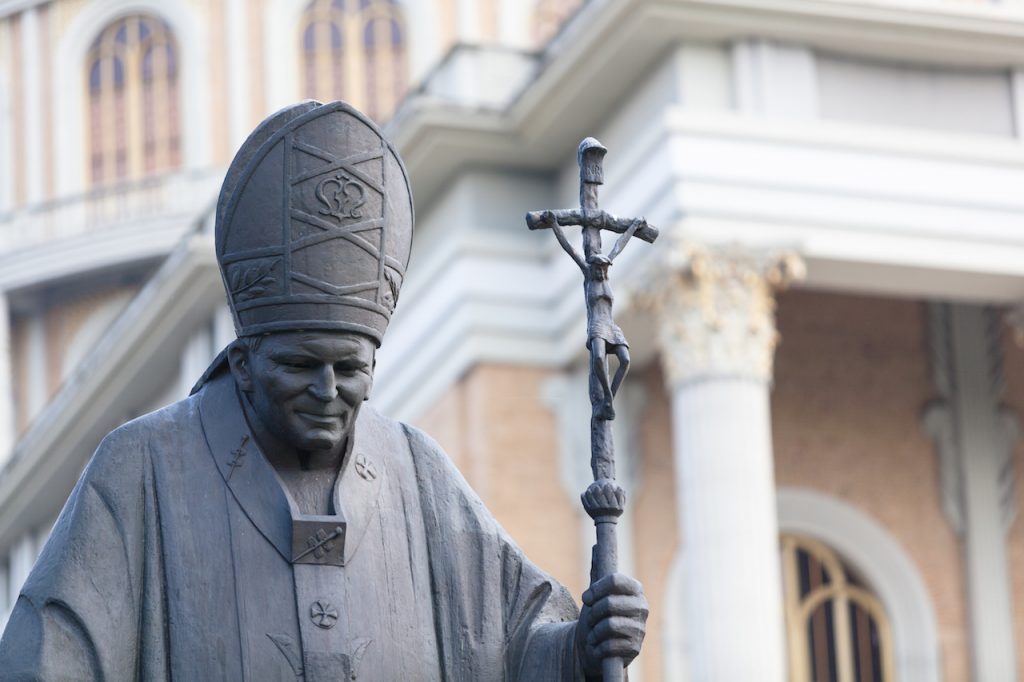This essay is part of our collection on the legitimacy of capital punishment. See the full collection here.
In yesterday’s essay I explored the question whether the traditional justification of intentional killing in capital punishment was a matter of Christian divine revelation or extraordinary dogmatic (i.e., infallible) teaching of the Catholic Church. I concluded it was neither. Today’s essay asks whether, in virtue of the consistency and ancient nature of the traditional affirmation, a Catholic is bound in faith nevertheless to affirm the legitimacy of penal killing by the state.
The gift of infallibility that Catholics believe Jesus gave to the Twelve Apostles and their successors to protect Christians from damnable error not only guards extraordinary acts of teaching (by a pope or council), but also—under precise conditions—the ordinary teaching of the pope and bishops. Has the death penalty’s legitimacy been guaranteed through this expression of infallibility, the infallibility of the Ordinary and Universal Magisterium (see Lumen Gentium 25)?
Vatican II teaches that four conditions must be met simultaneously for infallibility to be invoked by the Ordinary and Universal Magisterium: that (1) the bishops preserve a bond of communion amongst themselves and with the pope; (2) they teach some matter of faith or morals authentice (“authentically,” i.e., in their capacity as bishops; so Augustine’s De Civitate Dei is not a text of the magisterium); (3) they conveniunt (agree, come together, unite) in a single judgment (sententiam); and (4) they teach it definitive tenendam (as to be definitively held; i.e., as to be assented to as if it pertained to the deposit of faith).
Start your day with Public Discourse
Sign up and get our daily essays sent straight to your inbox.In my book, I conceded that the first three conditions had probably been met, but not the fourth. I conceded too much. After reflection, I now think none of the conditions has been met. For the first through third conditions to have been met, the bishops as successors of the Twelve would at some point in history have had to unite in a common judgment that capital punishment was good and salubrious, and then authentically to have taught that judgment to the faithful. Although some bishops taught it authentice, the number appears actually to be very few. Out of the tens of thousands of Catholic bishops who have served Christ’s Church, I am only able to identify a handful in Catholic history that authentically taught the death penalty’s legitimacy. Moreover, not only must they have agreed in a common judgment and authentically taught that judgment to the faithful; they must have taught it as to be definitively held, that is, proclaimed it to be held as pertaining to the deposit of faith. But very few ever taught it in this way.
Not Definitively Held
In their book, By Man Shall His Blood Be Shed: A Catholic Defense of Capital Punishment, Edward Feser and Joseph Bessette argue from the fact that most bishops believed the death penalty’s legitimacy was grounded in the teaching of Sacred Scripture to the conclusion that whenever they taught it they must have taught it definitive tenendam: “in order to believe (as Brugger does) that conditions 1, 2, and 3 have been met while 4 has not, you have to believe that the bishops have regarded the legitimacy in principle of capital punishment to be both divinely revealed and not to be definitively held. And that, needless to say, is absurd.”
This is confused. It does not matter what the bishops “regarded” to be the case. What matters is the manner in which they taught and teach propositions. This implies, and experience confirms, that bishops routinely teach in order to explain and apply Christian doctrine in ways that are not proposed as to be definitively held. Most often bishops are prompted to teach definitive tenendam when there is active opposition to some teaching. Other than Innocent III’s conflict with the Waldensian heretics in the thirteenth century, there has been relatively little Catholic opposition to the death penalty until the twentieth century, at which point the tendency for Catholic bishops was to question the death penalty’s legitimacy, not to affirm it definitive tenendam.
There is little evidence from the patristic period of bishops proposing the death penalty’s legitimacy in this manner. In a private letter, Pope Leo the Great assumes its legitimacy, but asserts nothing about its morality. Pope Gregory the Great, in a letter to a bishop, makes a passing reference to the death penalty, but he teaches no explicit proposition on its legitimacy (so a fortiori teaches nothing definitive tendendam). I am happy to concede that the following statement by Innocent I was taught definitive tenendam: “How therefore would they criticize something [the death penalty] which they see to have been granted through the authority of God . . . lest we may seem either to overturn sound order or to go against the authority of the Lord” (Epistle VI, to Exsuperius; PL, vol. 20, col. 499a-b)). But this is one of very few. Among the many places where Augustine teaches on capital punishment, only in one does he appear to have taught its legitimacy definitive tendendam. Neither Cyprian nor Chrysostom speaks directly about capital punishment, even though the opinions of both can be gathered from what they say.
Among medieval authors, Innocent III’s Waldensian Oath likely should be considered to have been taught definitive tenendam. But the teachings of the Councils of Toledo, Lateran IV, and the Decretals of Gregory IX do no more than allow us to gather the opinions of the times. During the post-Reformation period, Leo X’s condemnation in 1520 in the bull Exsurge Domine of a proposition ascribed to Martin Luther, “That heretics be burned is against the will of the Spirit” (which it probably was), does not assert the death penalty’s legitimacy, but merely asserts that Luther’s proposition is among a set of propositions whose content is either heretical or scandalous or false or offensive to pious ears, and thus obstructive to Catholic truth (Denzinger, 43rd ed., no. 1483). Between Trent and Vatican II, very few bishops asserted anything about the death penalty’s legitimacy.
However uncomfortable it makes Feser and Bessette, the evidence demonstrates that relatively few bishops of the Catholic Church have taught on the morality of capital punishment, and among those who have, even fewer have ever admonished the faithful to hold its legitimacy as a matter of divinely revealed truth. The evidence is inadequate for claiming that its legitimacy has been taught infallibly by the Ordinary and Universal Magisterium.
In denying the existence of a common episcopal judgment on capital punishment taught definitive tenendam, I am not denying a common opinion among churchmen and theologians. But opinion is not a locus for divine guarantee; nor does it constitute ecclesial judgment; and unless propositionally asserted as true by a sacred writer, does not constitute divine revelation. The Holy Spirit does not guide and guard opinions. He guides and guards the acts of authentic teaching of the successors of the Twelve.
So the fact that many Catholics, including Fathers and bishops, believed until recently that capital punishment was legitimate is of itself irrelevant to what you or I, believing that the Holy Spirit guides the Church’s formal teaching, are required in faith to believe. Many Fathers and bishops have also believed things about slavery, torture, the coercion of heretics, and retributive warfare that the Catholic Church manifestly does not teach by the protection of the Holy Spirit.
St. John Paul II’s Principled Opposition to Capital Punishment
Feser and Bessette argue that “Brugger simply has no serious grounds for attributing to Pope Saint John Paul II the extreme position that he does.” I have very serious grounds. The saintly pope carefully laid down theoretical foundations and introduced methodological indicators that provide a clear basis for a Catholic teaching rejecting the death penalty in principle.
The following four points, which are drawn from the authoritative edition of the Catechism of the Catholic Church (CCC-1997), the most authoritative promulgation on the death penalty of John Paul II’s pontificate, summarize the argument. (For an elaboration of the argument, see the first chapter of Capital Punishment and Roman Catholic Moral Tradition.)
First, the subsection in which the death penalty is treated is entitled “Legitimate Defense.” Before John Paul II, there are no cases in ecclesial teaching—none—and almost none in theological literature where capital punishment is assessed as a kind of self-defense. Aquinas never uses the term. He does use the related term “blameless defense,” but never in reference to punishment. He uses it rather in his treatment of lawful killing by private persons in self-defense. “Legitimate defense” is also used by Liguori, Zalba, Aertnys and Damen, the 1917 and 1983 Codes of Canon Law, and by many others in the tradition, always in discussions of the conditions for legitimate killing by private persons in self-defense. Vatican II also uses it in reference to self-defensive wars (this, by the way, is a parallel development in Catholic moral tradition—the shift away from defending retributive wars to defending self-defensive wars only).
Second, the CCC tells us that the types of killing it will address—following a legitimate defense paradigm—should be assessed according to double effect reasoning: “The act of self-defense can have a double effect: the preservation of one’s own life; and the killing of the aggressor. . . . The one is intended, the other not.” The quote references Aquinas’s influential treatment of killing in self-defense, at the heart of which is the requirement that the killing must be praeter intentionem, that is, not part of one’s intended end or means.
Third, if there were any doubt that the CCC means to subsume capital punishment under a double-effect paradigm, paragraph 2267, treating the death “penalty,” refers twice to the subjects of capital punishment as “aggressors”; and it says the purpose of killing them is “rendering one who has committed an offense incapable of doing harm.” Anyone mildly familiar with the literature in the Church’s long tradition of justifiable homicide will recognize that these are terms-of-choice in catechisms, manuals, and nearly every treatment on justifiable killing for the last 800 years. But never in regard to treatments of capital punishment. Always and everywhere they are used to assess lethal force by private persons in self-defense. And the act of killing—so the tradition unanimously affirms—must be praeter intentionem.
Finally, in 1992 the CCC still affirmed that intentional killing could be used as a form of retributive punishment: “the traditional teaching of the Church has acknowledged as well-founded the right and duty of legitimate public authority to punish malefactors by means of penalties commensurate with the gravity of the crime, not excluding, in cases of extreme gravity, the death penalty.” The language of grave crimes and commensurate punishments situates this comfortably within the tradition defended by Feser and Bessette.
But to reinforce the move away from retribution and toward double-effect reasoning, the definitive edition of the CCC deletes its reference to retributive killing: “Legitimate public authority has the right and the duty to inflict punishment proportionate to the gravity of the offense. Punishment has the primary aim of redressing the disorder introduced by the offense…” The deletion was very deliberate. What happened between the first and second editions (in other words, between 1992 and 1997)? John Paul II published his anti-death-penalty encyclical Evangelium vitae.
Let me say it again: no authoritative ecclesial text before the pontificate of John Paul II ever evaluated capital punishment using a model for assessing killing by private persons in self-defense, in which the killing, to be lawful, must not be intended.
But if capital punishment is truly punishment, then the criminal’s death is intended as a means to redressing the disorder caused by his crime.
If instead the death “penalty” is justified only as self-defense, analogous to legitimate self-defense in the individual case, then—as Aquinas and the tradition have uniformly held of the individual case—the killing it involves must be outside the actor’s intention. In that case, the legitimacy of the death “penalty” is no exception to the norm: no intentional killing whatsoever. And it remains open to say that the death penalty—the intentional infliction of death as a means to retributive justice—is per se impermissible.
Feser and Bessette argue that because the CCC teaches the principle “that offenders deserve punishment and the principle that the punishment should be proportional to the gravity of the offense,” it necessarily follows “that execution can in principle be legitimate as punishment.” Therefore, they reason, the CCC “implicitly” teaches the death penalty’s legitimacy.
We might freely concede that many criminals “deserve” to die (Scripture even suggests we all do due to our sins), but it does not follow that anyone has the moral right to kill them (or us). Feser and Bessette’s conclusion no more follows from their premises than does the conclusion that a rapist should be raped for punishment because (1) he deserves punishment, and (2) rape is proportional to the gravity of his offense. If it is wrong intentionally to kill, then killing criminals, like raping them, is excluded from the range of acceptable proportionate punishments. No denial of the principles of desert or proportionate punishment is entailed.
St. John Paul II clearly meant to lay down premises for reassessing the death penalty. As the Successor of Peter, John Paul was keenly aware of the longstanding Catholic tradition defending it. As a brilliant Catholic scholar and a saint, he seemed to believe that retributive killing was wrong. But aware of the fallibility of human reason, he meant to introduce into the authoritative conversation these obvious theoretical markers tending toward principled abolitionism and to allow the Holy Spirit to guide the Church in all truth. Relativizing his teaching does not contribute to that effort.
The 1997 Catechism clearly means to treat the death penalty as a form of self-defense and clearly means that the killing it entails must be outside the intention. The act it justifies using the term capital “punishment”—which is not really punishment at all, but a form of self-defense—does not contradict the norm: no intentional killing whatsoever. And it remains open to say that the death penalty as retributive intentional killing is always wrongful.
The CCC is authoritative for Catholics. Its reasoning on capital punishment, even if non-traditional, is not contrary to any definitive teachings of the Church. Therefore, Catholics may legitimately affirm that the death penalty is per se wrongful.
Since the legitimacy of intentionally killing criminals is not a definitive doctrine of the Catholic Church, and since three pontiffs have now taught that the morality of legitimate killing must be assessed in terms of self-defense, it follows that the Catholic Church can declare that the death penalty as intentional killing is always inadmissible.
E. Christian Brugger is Senior Research Fellow of Ethics and the Culture of Life Foundation in Washington, DC. He would like to thank Sherif Girgis for extensive comments on this essay in draft.














